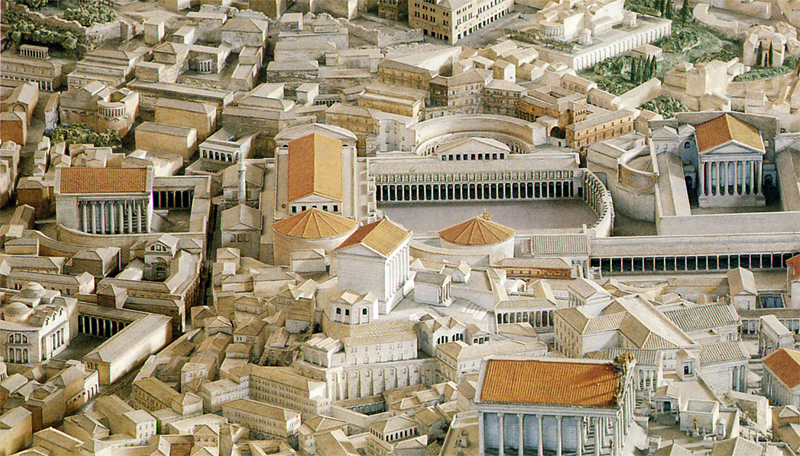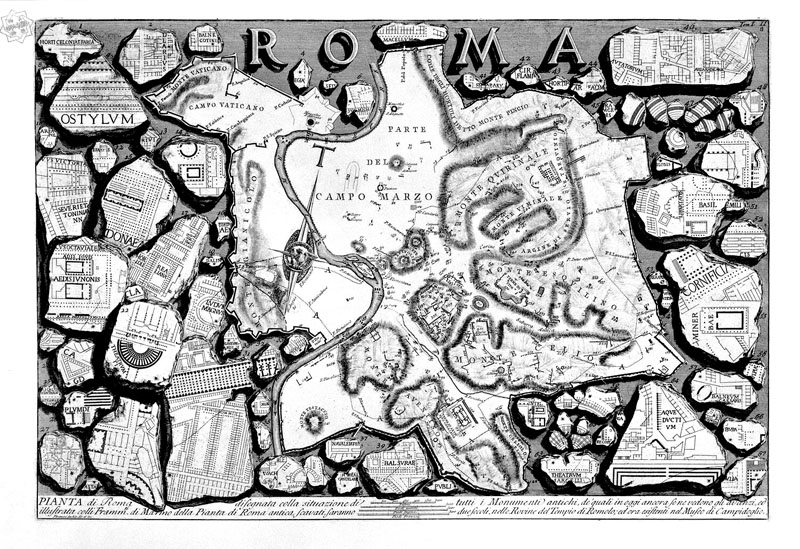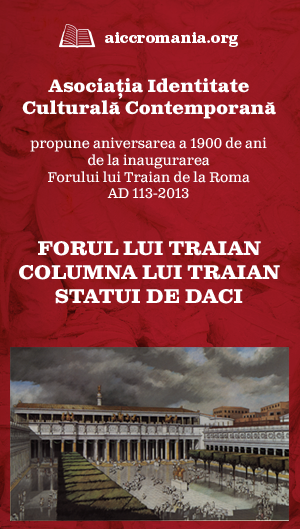Italo GISMONDI (born August 12, 1887 in Rome - died in the same city in December 2, 1974) is an Italian architect and archaeologist, specialist in ancient Roman history.
In 1910 Italo Gismondi was admitted as an administrator of Antiquities and Fine Arts, and was appointed director of excavations at Ostia, a task that will practice for 44 years. From 1919 until 1938 Gismondi was also responsible for the remains of ancient Rome.
The ancient city of Ostia was the prime focus of Gismondi's work, which was particularly interested in architectural aspects of ancient buildings.
As an architect, he has done numerous projects, including the plan of the imperial Forums of Rome, conducted in 1933; in 1927 he restored the north-west side of the "baths of Diocletianus" (built between 298-306 AD), as well as other works performed in the same complex.
During 1935 and 1971 Gismondi will work to make the famous model of ancient Rome, which is currently stored at Museo della Civiltà Romana in Rome, resuming the concept of Paul Bigot1,
made at the scale of 1:250, the model represents the city of Rome during the reign of Constantinus (306-337 AD), by the early IV AD century.
Gismondi's archaeological work was very important in Italy, in the regions of Abruzzo, Molise, Umbria and in eastern Sicily, as well as abroad, in Libya, in the ancient Greek city of Kyrene and in Tripoli region.
The great model of Rome was made by Italo Gismondi (in plaster), based on scientific information and it represents the known constructions, or those that appear on the great plan of Rome (Forma Urbis Severiana)2
of Lucius Septimius Severus Pertinax period (193-211 AD) and after Forma Urbis Romae3 of the well known Italian archaeologist Rodolfo Lanciani (1845-1929).
The model measures approximately 270 m2, and is regularly updated depending on the new discoveries.
The plan of Rome in the IVth century AD, made by Paul Bigot, detail - the area of the Forum of Trajan, MRSH, University of Caen (France).The plan of Rome in the IVth century AD, made by Paul Bigot, detail - the area of the Forum of Trajan, MRSH, University of Caen (France).
James E. Packer, a professor at Northwestern University, Department of Classics, Evanston, Illinois (USA), made in 1972 the graphical reconstruction of Trajan's Forum4 ;
Part of the Forum of Trajan was revealed in the years 1812-1814 and 1828-1833, but the whole of the reports (reports) of the excavation was never published. Researchers had long highlighted the role of the Forum of Trajan as a model for the buildings and the forums built thereafter. Yet, the plans and volumes were known only approximately until in 1972 James E. Packer undertakes the graphic reconstruction of the monuments. The new reconstruction of Trajan's Forum is based on the information brought by Forma Urbis5,
on the silhouettes of the buildings reproduced on the coins from the time of Trajan,
, on the drawings, restorations and reconstructions made by the architect and archaeologist Italo Gismondi (1887-1974),6,
on the succinct descriptions of ancient authors as wellas on the new plan developed by the Getty Center7 and 1:1 scale reproduction of the fragments still present on the spot (in situ), which allow quite accurate reconstructions.
The model made by The Urban Simulation Team based on James E. Packer’s researches
http://www.ust.ucla.edu/ustweb/Projects/trajans_forum.htm

ig. Reconstruction of the assembly of the monumental market of Trajan's Forum: south façade of the building Basilica Ulpia and the north-east side of the portico of the Forum, James E. Packer, The Forum of Trajan in Rome. A Study of the Monuments in Brief, University of California Press, 2001.

Fig. Forma Urbis Romae or Forma Urbis Severiana ; a drawing made in 1756 by Giovanni Battista Piranesi (1720-1778).

Fig. Ancient Rome - reconstruction made by Gilles Chaillet (1946-2011), writer and illustrator of the book series "bande dessinée" such as Adventures of Guy Lefranc, series "Vasco", several episodes of Voyages d'Alix.
- Paul Bigot, born on October 20, 1870 at Orbec (Calvados) - died in Paris on June 8, 1942, is a French architect. He attended architectural studies at Paris, at “Ecole Nationale Superieure des Beaux-Arts". During his professional stay in Rome at "Villa Médicis - Académie de France “(he obtained "Grand Prix de Rome" in 1900), Paul Bigot presented the model of the widest ancient Roman public building ever built, "Circus Maximus" , the oldest racecourse in Rome where spectacular racing of carts pulled by horses took place. Then he made in relief (in painted plaster, 11/6 m, with about 70 m2 in size, scale 1/400) an evocation of the ancient Rome, plan-relief that he will exhibit in Rome at the "Exposition Internationale", in 1911, in the Department of Archaeology. Currently, the model made by Paul Bigot is located at the University of Caen (France), installed in 1996 in "Nouvelle Maison de la Recherche en Sciences Humaines".
- Forma Urbis Romae or Forma Urbis Severiana was a huge marble map of ancient Rome, made during the reign of Emperor Lucius Septimius Severus Pertinax (193-211), between 203 and 211, exposed on the inner wall of the Forum of Peace, it measure 18 m wide by 13 m high.
- Forma Urbis Romae Lanciani - the map of ancient Rome made by Italian Amedeo Rodolfo Lanciani (1845-1929), an archaeologist responsible for most of the excavation sites in Rome at the end of 19th century.
Between 1893 and 1901 he made this detailed map at the 1:2000 scale of the center of ancient Rome in 46 drawings, as well as the cartographic inventory of the vestiges of Rome. - For the reconstruction of the Forum of Trajan, see: James E. Packer, Kevin Rose Mary Sheldon et Sarring Lee, "A New excavation in Trajan's Forum", in American Journal of Archaeology, vol 87, no. 2, April 1983, p 165-172, "Foro Traiano. Contributi per una ricostruzione storica e architettonica" in Archeologia Classica, Vol XLI, 1989, with the following contributions: Pensabene," Premessa ", p 27-32, Milella M., Pensabene P.," Introduzione store is quadro architectonico » , p 33-54, Milella M., "I ritrovamenti", p 55-100, Piazzesi G., "Gli edifices: ipotesi ricostruttive", p 125-214, L. Ungaro, L. Messa, "Pannella rilievi con d'Armi di dal Foro Traiano: preliminary note ", p 215-236 and S. Stucchi," Tantis Viribus. L'general area concezione della Colonna del Foro di NELLA Traiano ", p 237-291, James E. Packer," Trajan's Forum in 1989 "(Review article), the American Journal of Archaeology, vol 96, 1992, p 151-162, and the Forum of Trajan in Rome. A study of the monuments, (3 volumes) University of California Press, 1997.
- Forma Urbis Romae or Forma Urbis Severiana was a huge marble map of ancient Rome, made during the reign of Emperor Lucius Septimius Severus Pertinax (193-211), between 203 and 211, exposed on the inner wall of the Forum of Peace, it measure 18 m wide by 13 m high.
- Italo Gismondi (1887-1974), a famous Italian architect and archaeologist who made between 1935 and 1971 the famous model of ancient Rome, which is currently exhibited at Museo della Civiltà Romana, in Rome. The model is made in plaster, it measures approximately 270 m2, and is regularly updated depending on the new discoveries.
- "Getty Center" is a set of cultural and research buildings located in Los Angeles, California (USA), built by the architect Richard Meier on a hillside of the neighborhood of Brentwood. In this campus is located a part of the museum "J. Paul Getty Museum" (the other is located in "Getty Villa"), as well as the "Getty Research Institute" and "Getty Conservation Institute." The Getty Center was opened on December 16, 1997; the works lasted for 12 years, from 1985 to 1997. The Center consists of six buildings covering an area of 88,200 m². Architect Richard Meier wanted to give the campus an appearance of an “Italian village on hillsides.”



















